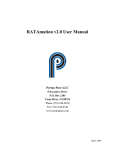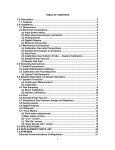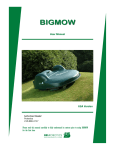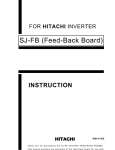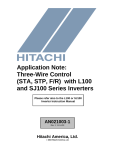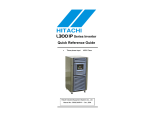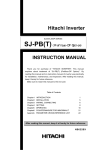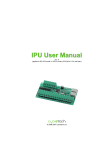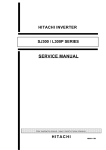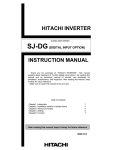Download Hitachi SJ300 Welding System User Manual
Transcript
SJ-EN Ethernet Communications Option Board Instruction Manual • SJ300 Series • L300P Series NOTE: REFER ALSO TO SJ300 or L300P SERIES INSTRUCTION MANUAL Manual Number: HAL1051 December 2004 After reading this manual, keep it handy for future reference. Hitachi America, Ltd. NOTES: Table of Contents Table of Contents Table of Contents................................................................................................................... 3 Chapter 1 – General Description .......................................................................................... 5 Chapter 2 – Installation and Wiring...................................................................................... 9 Chapter 3 – Configuration................................................................................................... 13 Chapter 4 – Operation ......................................................................................................... 17 Chapter 5 – Troubleshooting .............................................................................................. 19 Appendix – Parameter List ................................................................................................. 20 Index ..................................................................................................................................... 35 Page 3 of 36 Table of Contents NOTES: Page 4 of 36 Chapter 1 Chapter 1 – General Description The SJ-EN option board is an Ethernet communication interface for the Hitachi SJ300 and L300P series of AC Variable Frequency Inverters. The board can be installed in one of the two available option slots in the inverter. The SJ-EN uses the open MODBUS/TCP communication protocol. It utilizes a 10Base-T physical interface with a 10 Mbps data transfer rate. Even though the board uses the MODBUS/TCP, this does not necessarily mean that all MODBUS services and functions are supported. Detailed description of the available functionality is provided in Chapter 4 of this manual. The board will act as a MODBUS/TCP slave that can be read from and written to over the Ethernet network from a MODBUS/TCP master device. It will not initiate communication with other devices on the network. It will only respond to requests from a master device. The SJ-EN will allow a user to control the operation of the inverter, monitor its operation, and modify parameters. Before using this product, please read this manual and the relevant inverter manual, and be sure to follow all safety precautions noted therein. After unpacking the SJ-EN board, carefully inspect it for any defect or damage, and be sure all parts are present. Carton Contents (1) SJ-EN Ethernet Communication Interface Board (2) Screws to secure board to inverter case (M3 x 8mm) (1) CD-ROM containing this manual (pdf) and NetEdit3 software WARRANTY The warranty period under normal installation and handling conditions shall be eighteen (18) months from the date of purchase, or twelve (12) months from the date of installation, whichever occurs first. The warranty shall cover repair or replacement, at Hitachi’s sole discretion, of the SJ-EN Option board. Service in the following cases, even within the warranty period, shall be to the customers account: 1. Malfunction or damage caused by misuse, modification or unauthorized repair. 2. Malfunction or damage caused by mishandling, dropping, etc., after delivery. 3. Malfunction or damage caused by fire, earthquake, flood, lightning, abnormal input voltage, contamination, or other natural disasters. If service is required for the product at your worksite, all expenses associated with field repair are the purchaser’s responsibility. This warranty only covers service at Hitachi designated service facilities. If making a warranty claims in reference to the above, please contact the distributor from whom you purchased the SJ-EN, and provide the model number, purchase date, installation date, and description of damage or missing components. Page 5 of 36 Chapter 1 SAFETY PRECAUTIONS HIGH VOLTAGE: This symbol indicates high voltage. It calls your attention to items or operations that could be dangerous to you and other persons operating this equipment. Read the message and follow the instructions carefully. WARNING: Indicates a potentially hazardous situation that, if not avoided, can result in serious injury or death. CAUTION: Indicates a potentially hazardous situation that, if not avoided, can result in minor to moderate injury, or serious damage to the product. The situation described in the CAUTION may, if not avoided, lead to serious results. Important safety measures are described in CAUTION (as well as WARNING), so be sure to observe them. HIGH VOLTAGE: Motor control equipment and electronic controllers are connected to hazardous line voltages. When servicing drives and electronic controllers, there may be exposed components with housings or protrusions at or above line potential. Extreme care should be taken to protect against shock. Stand on an insulating pad and make it a habit to use only one hand when checking components. Always work with another person in case an emergency occurs. Disconnect power before checking controllers or performing maintenance. Be sure equipment is properly grounded. Wear safety glasses whenever working on electronic controllers or rotating machinery. WARNING: This equipment should be installed, adjusted, and serviced by qualified electrical maintenance personnel familiar with the construction and operation of the equipment and the hazards involved. Failure to observe this precaution could result in bodily injury. WARNING: HAZARD OF ELECTRICAL SHOCK. DISCONNECT INCOMING POWER BEFORE WORKING ON THIS CONTROL. WARNING: Wait at least five (5) minutes after turning OFF the input power supply before performing maintenance or an inspection. Otherwise, there is the danger of electric shock. WARNING: Do not install or remove the SJ-EN Ethernet option board while the inverter is energized. Otherwise there is the danger of electric shock and/or fire. WARNING: Never modify the unit. Otherwise, there is a danger of electric shock and/or injury. CAUTION: Be sure to secure the SJ-EN option board with the supplied mounting screws. Make sure all connections are made securely; otherwise there is danger of a loose connection and unpredictable operation. CAUTION: Alarm connection may contain hazardous live voltage even when inverter is disconnected. When removing the front cover for maintenance or inspection, confirm that incoming power for alarm connection is completely disconnected. Page 6 of 36 Chapter 1 CAUTION: Be sure not to touch the surface or terminals of the SJ-EN Ethernet option board while the inverter is energized; otherwise there is the danger of electric shock. CAUTION: The software lock modes described in the SJ300 inverter manual are NOT supported via the SJ-EN option board. This means that network commands can bypass any software lock settings configured via the inverter keypad. It is incumbent on the user to make sure no safety lockouts are violated through network commands. CAUTION: When configuring parameters with the standard keypad, the inverter checks for and inhibits invalid parameter combinations when the STR key is pressed. The SJ-EN bypasses this check, so it is incumbent on the user to make sure invalid configuration parameters or combinations are not sent through network commands. Otherwise undesirable inverter behavior may occur. CAUTION: Certain parameter data ranges vary depending on model and capacity. The SJ-EN does NOT check to make sure these data are within range. It is incumbent on the user to make sure data for these parameters is within range for the specific model and rating. These parameters are noted in the parameter tables in the Appendix. Otherwise undesirable inverter behavior may occur. INVERTER COMPATIBILITY The inverter firmware revision number is embedded within the inverter Manufacturing Number, which can be found on the product nameplate. The SJ-EN Ethernet Interface option board is compatible only with SJ300 and L300P series inverters with Revision Numbers HIGHER than those shown below. XX8KT XXXXX XXXXX – for SJ300-xxxXFU 0.4 kW (0.5 hp) to 55 kW (75 hp), or L300P-xxxXFU or L300P-xxxXBRM 1.5 kW (2 hp) to 75 kW (100 hp) XXEMT XXXXX XXXXX – for SJ300-xxxXFU 75kW (100 hp) to 150 kW (200 hp), or L300P-xxxXFU or L300P-xxxXBRM 90 kW (125 hp) to 132 kW (175 hp) Note: All inverters in the model number series L300P-xxxXFU2 are compatible with the SJ-EN, regardless of revision number. Page 7 of 36 Chapter 1 NOTES: Page 8 of 36 Chapter 2 Chapter 2 – Installation and Wiring Orientation to Product Features Figure 2-1 below shows the physical layout of the SJ-EN Ethernet option board. In particular, note the location of status LEDs and DIP-switches. STATUS LEDs • • • • STATUS LINK ACTIVITY ERROR Connector to connect to SJ300 or L300P (rear of board) RJ45 Jack 7 6 5 4 3 2 1 0 SJ-EN DIP Switches ON RXD LED OFF TXD LED Figure 2-1 SJ-EN Layout The pinout for the RJ45 connector is as follows: 1. 2. 3. 4. 5. 6. 7. 8. TX Data + TX Data – RX Data + NC NC RX Data – NC NC 8 7 6 5 4 3 2 1 Figure 2-2 SJ-EN RJ45 Pinouts Page 9 of 36 Chapter 2 Installing the Option Board Power down the inverter and wait at least five minutes before moving to the next step. Open and remove the lower terminal cover. Confirm that the red CHARGE LED is extinguished and that the DC bus is fully discharged before proceeding further, otherwise there is the danger of electric shock. Then remove keypad from the inverter. You can now remove the upper front cover to expose the two option ports inside. Figure 2-3 below shows how to install the option board to option port 1 or 2 of the inverter. There are four holes on the corners of the option board. Align the board with the port connector in the proper orientation (to the left, when facing the inverter as show). Then align the top two holes with the two screw holes, and the bottom two holes with the two guide posts. Insert the board fully into the connector. Secure the board with the two M3 screws supplied. Option board Guide posts for option board positioning Option port 1 Option port 2 Screw holes for securing the option board (M3 screws x 2) Figure 2-3 Installation of SJ-EN Page 10 of 36 Chapter 2 User Interface The SJ-EN has six LEDs to convey module status and activity. Four LEDs next to the RJ45 connector: • STATUS (GREEN) – This LED will be ON whenever the SJ-EN is receiving proper power from the inverter and the self diagnostics have shown the board to be functioning normally. • LINK (GREEN) – This LED is ON when the SJ-EN is receiving valid Ethernet pulses. • ACTIVITY (GREEN) – This LED is ON whenever there is Ethernet traffic in the cable. • ERROR (RED) – This LED will be ON if the SJ-EN has failed due to a hardware watchdog timeout, or the Ethernet communications has been absent for the software watchdog timeout period. Two LEDs near the right edge of the board: • TXD – This LED indicates communication from the SJ-EN to the inverter through the option port. • RXD – This LED indicates communication to the SJ-EN from the inverter through the option port. (These two LEDs may appear blinking or may appear steady ON due to the high blink rate.) Page 11 of 36 Chapter 2 NOTES: Page 12 of 36 Chapter 3 Chapter 3 – Configuration Install NetEdit3 Software NetEdit3 Software is provided on the CD-R enclosed with the SJ-EN option board. This software is required to configure the board. It can also be used to update the SJ-EN firmware in the event of a future update. NetEdit3 is compatible with Microsoft® Windows® 98, Windows ME, Windows 2000, Windows XP, and Windows NT4. In Windows, run the program “SetupNE3.exe” on the CD-R to install the program. Follow the on-screen instructions to complete the installation. Configuration of the SJ-EN Board Ensure that the SJ-EN is properly installed as described in Chapter 2. Attach a standard Ethernet Crossover cable to the RJ45 connector on the SJ-EN. Connect the other end to the RJ45 port of a Windows PC with an Ethernet adapter installed. If connecting the SJ-EN to a hub, switch or router, use a patch (straight-through) cable instead. For best results, use Category 5, commercial quality cables rated for 10BaseT applications. There are 8 DIP-switches on the SJ-EN board (see Figure 2-1). Switches 6 and 7 are not used. Switches 0 to 5 may be used to set a 6-bit binary number representing 000001 to 111111 binary or 1 to 63 in decimal, for a device (module) ID. However, for normal Modbus/TCP use, switches 0-5 should all be set to ZERO (off). When configured that way, the device ID is obtained from board’s FLASH memory. The value will be programmed into the SJ-EN flash memory by means of the NetEdit3 software; this ID can be any 32-bit binary value (i.e. 0 to 4,294,967,295 decimal). Make sure that all wiring is secure in the inverter, and that the power connections are free and clear. Be sure to separate power wiring from control wiring. If they have to be crossed, be sure that they cross at a right angle. Connect the inverter to the PC Ethernet port, and that the PC is started and running Windows. Power up the inverter, and observe the LEDs on the SJ-EN board. The STATUS LED should be illuminated, and the LINK, ACTIVITY, RXD and TXD LEDs should be blinking (may appear as though ON continuously, due to high blink rate). The red ERROR LED should NOT be illuminated. See Chapter 4 for detailed description of LED functions. If the LED conditions are not correct, proceed to Chapter 5 for Troubleshooting. If you power up the inverter before powering up the PC, an error code may appear. After powering up the PC and properly connecting the cable, you should be able to clear the error with the STOP/RESET key on the inverter keypad. If the LEDs are correct, power down the inverter again. After the inverter CHARGE LED has extinguished, replace the covers on the inverter and reinstall the keypad. Then you can power up the inverter and continue with the configuration. Set Up the SJ-EN with NetEdit3 With the inverter powered up and the Ethernet cable connected from the SJ-EN to your PC, launch the NetEdit3 program. Figure 3-1 shows the initial screen on program start-up. Should an error code appear on the inverter display at power-up, simply press the STOP/RESET key on the keypad to clear it. Page 13 of 36 Chapter 3 Figure 3-1 NetEdit3 Initial Screen The NetEdit3 software should find and list any SJ-EN attached to the network. If not, just click on “Scan Network”. An entry will appear in the Device List (grid area), with the board details as shown in Figure 3-2. If more than one board is connected in a common network, you will see a line entry for each of them. The “Module Info” and “General Settings” tabs will now also appear next to the “General Help” tab, below the Device List. You can then click on the line for the board you wish to configure, and click on the “General Settings” tab and then the “General” button to bring up the General Settings dialog box containing the device details, or you can simply double-click on the device in the Device List. In the General Settings dialog box (Figure 3-3), you can enter the Module ID for the device, provided the DIP Switches on the board are all set to zero. Otherwise, the Module ID will reflect the DIP switch setting, and will be grayed out, indicating it cannot be modified with NetEdit3. You can also input a Name for the device, and a Description. The default Name will be “Hitachi Drive”, and the default Description will be “SJ300/L300P Hitachi Drive”. The device’s IP Address will also be shown. Change this to the desired IP address for your Modbus/TCP network. Your master device will need this address to communicate with this node. Note that all SJ-EN boards ship with the default IP address of “255.255.255.255”. When you change the IP address, the NetEdit3 software may no longer be able to see it in TCP/IP mode if the PC’s IP address is not on the same sub-network. You can communicate to the SJ-EN despite this using the IPX mode, however you will have to make sure IPX support is installed in Windows on that PC. Once you have made the necessary changes, you can exit NetEdit3, and disconnect the cable from your PC to the SJ-EN board. You may now connect the SJ-EN to your network to begin normal operation. Page 14 of 36 Chapter 3 Figure 3-2 NetEdit3 Screen after Scan of Network Figure 3-3 NetEdit3 General Settings Dialog Box Page 15 of 36 Chapter 3 NOTES: Page 16 of 36 Chapter 4 Chapter 4 – Operation Setting Up the Inverter for Ethernet Network Operation Once the SJ-EN board has been properly configured and connected to a network as described in Chapter 3, it is capable of reading data from and writing data to the inverter. However if it is desired to have either the RUN command and/or the speed reference come from the Ethernet master, you must change two inverter parameters as shown in the following table. Function Code A001 A002 Defaults Run Mode Edit Lo Hi –FE (EU) –FU (US) –FR (Jpn) Frequency Source Setting Six options; select codes: 00 Keypad potentiometer 01Control terminal 02 Function F001 setting 03 RS485 serial command 04 Expansion board 1 05 Expansion board 2 88 01 01 01 02 Run command source setting Five options; select codes: 01 Input terminal [FW] or [RV] (assignable) 02 Run key on keypad, or digital operator 03 RS485 serial command 04 Start/Stop, expansion card #1 05 Start/Stop, expansion card #2 88 01 01 01 02 Name Description Setting for Ethernet Control Supported MODBUS Functions The SJ-EN is implemented with the MODBUS/TCP communication protocol. It supports the following MODBUS functions: • READ MULTIPLE REGISTERS (03) – This function reads the contents of a contiguous block of holding registers in the inverter. • READ INPUT REGISTERS (04) – This function reads from 1 to up to around 125 contiguous input registers in the inverter. • WRITE SINGLE REGISTER (06) – This function will write to a single holding register in the inverter. • WRITE MULTIPLE REGISTERS (16) – This function will write to a block of contiguous registers in the inverter. Additional MODBUS/TCP protocol details, including specifications, application information, implementation guides, and other resources are available from the web site www.modbus.org. Page 17 of 36 Chapter 4 NOTES: Page 18 of 36 Chapter 5 Chapter 5 – Troubleshooting In general, the first step to troubleshooting should be to inspect the status LEDs on the SJ-EN board, in addition to the inverter operator/keypad display. These will give valuable clues to the nature of the problem. In addition, the inverter operator/keypad will provide diagnostic information for certain types of errors. Error codes for the option boards will have the format of: E6X.X for a board installed in option slot 1, or E7X.X for a board installed in option slot 2. The number to the right of the decimal point indicates the drive status at the time of trip, as follows: EXX.0 EXX.3 EXX.6 At reset At constant speed At starting EXX.1 EXX.4 During deceleration During acceleration EXX.2 EXX.5 During DC injection braking EXX.8 During overload restriction At stop EXX.7 f0 Stop The digit immediately to the left of the decimal point has the following meaning: Code EX0.X EX9.X TTTT Trip Name Ethernet Communication Error Internal Communication Error (between SJ-EN and inverter) Inverter Mismatch (blinking display as shown) Cause Check Remedy Defective connection Connectors (plugs & jacks), cable Replace or repair; press STOP/RESET on inverter keypad PC not powered up or not connected to inverter That PC is powered on and connected Press STOP/RESET on inverter keypad Network configuration error Verify proper Ethernet setup of SJ-EN and master device Reconfigure incorrect settings. Option board ajar or loose Verify board is properly seated in connector Remove and reseat board Board lockup Check status LEDs Press STOP/RESET key on inverter or cycle power Board defective Check status LEDs Replace SJ-EN Inverter firmware version not compatible with SJ-EN option board Inverter Manufacturing Number for version (see Page 7) Replace Inverter with later version Page 19 of 36 Appendix NOTES: Page 20 of 36 Appendix Appendix – Parameter List Note: Parameters in BOLDFACE can be edited while inverter is in the RUN mode. “RO” means the parameter is Read Only, and “R/W” means the value can be read or written. Inverter Parameter Modbus Start Address Modbus End Address Parameter Name Magnitude Read/ Write Data Range X1000 RO 0 – 400000 D – Monitoring Functions D001 3001 3002 Output frequency monitor D002 3003 3004 Output current monitor X10 RO 0 – 10000 D003 3005 3006 Rotation direction monitor X1 RO 0–2 D004 3007 3008 Process Variable (PV) PID feedback monitor X100 RO 0 – 999900 D005 3009 3010 Intelligent input terminal status X1 RO 0 – 65535 D006 3011 3012 Intelligent output terminal status X1 RO 0 – 65535 D007 3013 3014 Scaled output frequency monitor X1000 RO 0 – 39960000 D012 3023 3024 Output torque monitor X1 RO –300 – 300 D013 3025 3026 Output voltage monitor X10 RO 0 – 10000 D014 3027 3028 Input electric power monitor X10 RO 0 – 10000 D016 3031 3032 Cumulative RUN time monitor X1 RO 0– 4294836225 D017 3033 3034 Cumulative power–on time X1 RO 0– 4294836225 D080 3159 3160 Trip counter X1 RO 0 – 65535 D078 3155 3156 Last trip pointer X1 RO 0–5 D081 3161 3162 Error Code of Trip 1 X1 RO 0 – 255 D355 3709 3710 Frequency at Trip 1 X100 RO 0 – 40000 D356 3711 3712 Output current at Trip 1 X10 RO 0 – 10000 D357 3713 3714 PN voltage (DC voltage) at Trip 1 X10 RO 0 – 10000 D358 3715 3716 Cumulative RUN time at Trip 2 X1 RO 0– 4294836225 D359 3717 3718 Cumulative power–on time at Trip 2 X1 RO 0– 4294836225 D082 3163 3164 Error Code of Trip2 X1 RO 0 – 255 D361 3721 3722 Frequency at Trip 2 X100 RO 0 – 40000 D362 3723 3724 Output current of Trip 2 X10 RO 0 – 10000 D363 3725 3726 PN voltage (DC voltage) at Trip2 X10 RO 0 – 10000 D364 3727 3728 Cumulative RUN time at Trip 2 X1 RO 0– 4294836225 D365 3729 3730 Cumulative power–on time at Trip 2 X1 RO 0– 4294836225 D083 3165 3166 Error Code of Trip 3 X1 RO 0 – 255 Page 21 of 36 Appendix D367 3733 3734 Frequency at Trip 3 X100 RO 0 – 40000 D368 3735 3736 Output current at Trip3 X10 RO 0 – 10000 D369 3737 3738 PN voltage (DC voltage) at Trip 3 X10 RO 0 – 10000 D370 3739 3740 Cumulative RUN time at Trip 3 X1 RO 0– 4294836225 D371 3741 3742 Cumulative power–on time at Trip 3 X1 RO 0– 4294836225 D084 3167 3168 Error Code of Trip 4 X1 RO 0 – 255 D373 3745 3746 Frequency at Trip 4 X100 RO 0 – 40000 D374 3747 3748 Output current at Trip 4 X10 RO 0 – 10000 D375 3749 3750 PN voltage (DC voltage) at Trip 4 X10 RO 0 – 10000 D376 3751 3752 Cumulative RUN time at Trip 4 X1 RO 0– 4294836225 D377 3753 3754 Cumulative power–on time at Trip 4 X1 RO 0– 4294836225 D085 3169 3170 Error Code of Trip 5 X1 RO 0 – 255 D379 3757 3758 Frequency at Trip 5 X100 RO 0 – 40000 D380 3759 3760 Output current at Trip 5 X10 RO 0 – 10000 D381 3761 3762 PN voltage (DC voltage) at Trip 5 X10 RO 0 – 10000 D382 3763 3764 Cumulative RUN time at Trip 5 X1 RO 0– 4294836225 D383 3765 3766 Cumulative power–on time at Trip 5 X1 RO 0– 4294836225 D086 3171 3172 Error Code of Trip 6 X1 RO 0 – 255 D385 3769 3770 Frequency at Trip 6 X100 RO 0 – 40000 D386 3771 3772 Output current at Trip 6 X10 RO 0 – 10000 D387 3773 3774 PN voltage (DC voltage) at Trip 6 X10 RO 0 – 10000 D388 3775 3776 Cumulative RUN time at Trip 6 X1 RO 0– 4294836225 D389 3777 3778 Cumulative power–on time at Trip 6 X1 RO 0– 4294836225 D101 3201 3202 Output Frequency Monitor X1000 RO 0 – 400000 D102 3203 3204 DC Bus Voltage X10 RO 1 – 10000 D103 3205 3206 Accumulated BRD ON time X10 RO 1 – 1000 D104 3207 3208 E-Thermal Monitor X10 RO 1 – 1000 D106 3211 3212 MCU Version X1 RO 0 – 65535 Page 22 of 36 Appendix F – Main Profile Functions F001 4001 4002 Output frequency setting(Hz) / PID Setpoint (%) X1000 RO 0 – 400000 F002 4003 4004 Acceleration time 1 X100 R/W 1 – 360000 motor X100 R/W 1 – 360000 F202 4403 4404 Acceleration time 1, 2 nd rd F302 4603 4604 Acceleration time 1, 3 motor X100 R/W 1 – 360000 F003 4005 4006 Deceleration time 1 X100 R/W 1 – 360000 nd F203 4405 4406 Deceleration time 1, 2 motor X100 R/W 1 – 360000 F303 4605 4606 Deceleration time 1, 3rd motor X100 R/W 1 – 360000 F004 4007 4008 Keypad RUN key routing X1 R/W 0–1 A – Standard Functions A001 1 2 Frequency source setting X1 R/W 0–5 A002 3 4 Run command source setting X1 R/W 1–5 A003 5 6 Base frequency setting X1 R/W 30 – 400 motor X1 R/W 30 – 400 Base frequency setting, 3 motor X1 R/W 30 – 400 Maximum frequency setting X1 R/W 30 – 400 X1 R/W 30 – 400 A203 405 406 A303 605 606 A004 7 8 Base frequency setting, 2 nd rd A204 407 408 Maximum frequency setting, 2nd motor A304 607 608 Maximum frequency setting, 3rd motor X1 R/W 30 – 400 A005 9 10 [AT] selection X1 R/W 0–1 A006 11 12 [O2] selection X1 R/W 0–3 A011 21 22 [O]–[L] input active range start frequency X100 R/W 0 – 40000 A012 23 24 [O]–[L] input active range end frequency X100 R/W 0 – 40000 A013 25 26 [O]–[L] input active range start voltage X1 R/W 0 – 100 A014 27 28 [O]–[L] input active range end voltage X1 R/W 0 – 100 A015 29 30 [O]–[L] input start frequency select X1 R/W 0–1 A016 31 32 Analog input filter time constant X1 R/W 1 – 30 A019 37 38 Multi–speed operation selection X1 R/W 0–1 A020 39 40 Multi–speed frequency 0 X100 R/W 0 – 40000 X100 R/W 0 – 40000 nd A220 439 440 Multi–speed frequency 0, 2 motor A320 639 640 Multi–speed frequency 0, 3rd motor X100 R/W 0 – 40000 A021 41 42 Multi–speed frequency 1 X100 R/W 0 – 40000 Page 23 of 36 Appendix A022 43 44 Multi–speed frequency 2 X100 R/W 0 – 40000 A023 45 46 Multi–speed frequency 3 X100 R/W 0 – 40000 A024 47 48 Multi–speed frequency 4 X100 R/W 0 – 40000 A025 49 50 Multi–speed frequency 5 X100 R/W 0 – 40000 A026 51 52 Multi–speed frequency 6 X100 R/W 0 – 40000 A027 53 54 Multi–speed frequency 7 X100 R/W 0 – 40000 A028 55 56 Multi–speed frequency 8 X100 R/W 0 – 40000 A029 57 58 Multi–speed frequency 9 X100 R/W 0 – 40000 A030 59 60 Multi–speed frequency 10 X100 R/W 0 – 40000 A031 61 62 Multi–speed frequency 11 X100 R/W 0 – 40000 A032 63 64 Multi–speed frequency 12 X100 R/W 0 – 40000 A033 65 66 Multi–speed frequency 13 X100 R/W 0 – 40000 A034 67 68 Multi–speed frequency 14 X100 R/W 0 – 40000 A035 69 70 Multi–speed frequency 15 X100 R/W 0 – 40000 A038 75 76 Jog frequency setting X100 R/W 0 – 999 A039 77 78 Jog stop mode X1 R/W 0–5 A041 81 82 Torque boost method selection X1 R/W 0–1 nd A241 481 482 Torque boost method, 2 motor X1 R/W 0–1 A042 83 84 Manual torque boost value X10 R/W 0 – 200 X10 R/W 0 – 200 nd A242 483 484 Manual torque boost value, 2 motor A342 683 684 Manual torque boost value 3rd motor X10 R/W 0 – 200 A043 85 86 Manual torque boost frequency adjustment X10 R/W 0 – 500 A243 485 486 Manual torque boost frequency adjustment, 2nd motor X10 R/W 0 – 500 A343 685 686 Manual torque boost frequency, 3rd motor X10 R/W 0 – 500 A044 87 88 V/f characteristic curve selection, 1st motor X1 R/W 0–5* A244 487 488 V/f characteristic curve selection, 2nd motor X1 R/W 0–4* A344 687 688 V/f characteristic curve selection, 3rd motor X1 R/W 0–1 A045 89 90 V/f gain setting X1 R/W 20 – 100 A051 101 102 DC braking enable X1 R/W 0–1 A052 103 104 DC braking frequency setting X100 R/W 0 – 6000 A053 105 106 DC braking wait time X10 R/W 0 – 50 A054 107 108 DC braking force during deceleration X1 R/W 0 – 100 * A055 109 110 DC braking time for deceleration X10 R/W 0 – 600 A056 111 112 Selection of edge/level action of DC braking input [DB] X1 R/W 0–1 Page 24 of 36 Appendix A057 113 114 DC braking force for starting X1 R/W 0 – 100 * A058 115 116 DC braking time for starting X10 R/W 0 – 600 A059 117 118 DC braking carrier frequency X10 R/W 5 – 150 * A061 121 122 Frequency upper limit setting X100 R/W 0 – 40000 X100 R/W 0 – 40000 X100 R/W 0 – 40000 X100 R/W 0 – 40000 A261 521 522 Frequency upper limit setting, 2 motor A062 123 124 Frequency lower limit setting nd nd A262 523 524 Frequency lower limit setting, 2 motor A063 125 126 Jump frequency 1 X100 R/W 0 – 40000 A064 127 128 Width of jump frequency 1 X100 R/W 0 – 1000 A065 129 130 Jump frequency 2 X100 R/W 0 – 40000 A066 131 132 Width of jump frequency 2 X100 R/W 0 – 1000 A067 133 134 Jump frequency 3 X100 R/W 0 – 40000 A068 135 136 Width of jump frequency 3 X100 R/W 0 – 1000 A069 137 138 Acceleration pause frequency setting X100 R/W 0 – 40000 A070 139 140 Acceleration pause time setting X10 R/W 0 – 600 A071 141 142 PID Enable X1 R/W 0–1 A072 143 144 PID Proportional(P) gain X10 R/W 2 – 50 A073 145 146 PID Integral (I) time constant X10 R/W 0 – 36000 A074 147 148 PID Derivative (D) time constant X100 R/W 0 – 10000 A075 149 150 PID PV Scale conversion X100 R/W 1 – 9999 A076 151 152 PID PV source setting X1 R/W 0–1 A081 161 162 AVR function select X1 R/W 0–2 A082 163 164 AVR voltage select X1 R/W 0 = 200 V * 1 = 215 V 2 = 220 V 3 = 230 V 4 = 240 V 5 = 380 V 6 = 400 V 7 = 415 V 8 = 440 V 9 = 460 V 10 = 480 V A085 169 170 Operation mode selection X1 R/W 0–2* A086 171 172 Energy saving mode tuning X10 R/W 0 – 1000 A092 183 184 Acceleration time (2) X100 R/W 1 – 360000 X100 R/W 1 – 360000 A292 583 584 Acceleration time (2), 2 nd motor rd A392 783 784 Acceleration time (2), 3 motor X100 R/W 1 – 360000 A093 185 186 Deceleration time (2) X100 R/W 1 – 360000 A293 585 586 Deceleration time (2), 2nd motor X100 R/W 1 – 360000 X100 R/W 1 – 360000 A393 785 786 rd Deceleration time (2), 3 motor Page 25 of 36 Appendix A094 187 188 Select method to switch to acc2/dec2 profile X1 R/W 0–1 A294 587 588 Select method to switch to acc2/dec2 profile, 2nd motor X1 R/W 0–1 A095 189 190 Acc1 to Acc2 frequency transition point X100 R/W 0 – 40000 A295 589 590 Acc1 to Acc2 frequency transition point, 2nd motor X100 R/W 0 – 40000 A096 191 192 Dec1 to Dec2 frequency transition point X100 R/W 0 – 40000 A296 591 592 Dec1 to Dec2 frequency transition point, 2nd motor X100 R/W 0 – 40000 A097 193 194 Acceleration curve selection X1 R/W 0–3 A098 195 196 Deceleration curve selection X1 R/W 0–3 A101 201 202 [OI]–[L] input active range start frequency X100 R/W 0 – 40000 A102 203 204 [OI]–[L] input active range end frequency X100 R/W 0 – 40000 A103 205 206 [OI]–[L] input active range start current X1 R/W 0 – 100 A104 207 208 [OI]–[L] input active range end current X1 R/W 0 – 100 A105 209 210 [OI]–[L] input start frequency enable X1 R/W 0–1 A111 221 222 [O2]–[L] input active range start frequency X100 R/W –40000 – 40000 A112 223 224 [O2]–[L] input active range end frequency X100 R/W –40000 – 40000 A113 225 226 [O2]–[L] input active range start voltage X1 R/W –100 – 100 A114 227 228 [O2]–[L] input active range end voltage X1 R/W –100 – 100 A131 261 262 Acceleration curve constant X1 R/W 1 – 10 A132 263 264 Deceleration curve constant X1 R/W 1 – 10 B – Fine–Tuning Functions B001 1001 1002 Selection of automatic restart mode X1 R/W 0–3 B002 1003 1004 Allowable under–voltage power failure time X10 R/W 3 – 250 B003 1005 1006 Retry wait time before motor restart X10 R/W 3 – 1000 B004 1007 1008 Instantaneous power failure/under–voltage trip alarm enable X1 R/W 0–2 B005 1009 1010 Number of restarts on power failure/under–voltage events X1 R/W 0–1 Page 26 of 36 Appendix B006 1011 1012 Phase loss detection enable X1 R/W 0–1 B007 1013 1014 Restart frequency threshold X100 R/W 0 – 40000 B012 1023 1024 Level of electronic thermal setting, 1st motor X10 R/W 200 – 1200 B212 1423 1424 Level of electronic thermal setting, 2nd motor X10 R/W 200 – 1200 B312 1623 1624 Level of electronic thermal setting, 3rd motor X10 R/W 200 – 1200 B013 1025 1026 Electronic thermal characteristic, 1st motor X1 R/W 0–2 B213 1425 1426 Electronic thermal characteristic, 2nd motor X1 R/W 0–2 B313 1625 1626 Electronic thermal characteristic, 3rd motor X1 R/W 0–2 B015 1029 1030 Free setting electronic thermal frequency 1 X1 R/W 0 – 400 B016 1031 1032 Free setting electronic thermal current 1 X10 R/W 0 – 10000 B017 1033 1034 Free setting electronic thermal frequency 2 X1 R/W 0 – 400 B018 1035 1036 Free setting electronic thermal current 2 X10 R/W 0 – 10000 B019 1037 1038 Free setting electronic thermal frequency 3 X1 R/W 0 – 400 B020 1039 1040 Free setting electronic thermal current 3 X10 R/W 0 – 10000 B021 1041 1042 Overload restriction operation mode X1 R/W 0–3 B022 1043 1044 Overload restriction setting X10 R/W 500 – 2000 * B023 1045 1046 Deceleration rate at overload restriction X100 R/W 10 – 3000 B024 1047 1048 Selection of method of overload restriction 2 X1 R/W 0–3 B025 1049 1050 Overload restriction setting 2 X10 R/W 500 – 2000 * B026 1051 1052 Deceleration rate at overload restriction 2 X100 R/W 10 – 3000 B031 1061 1062 Software lock mode selection X1 R/W 0 – 10 B034 1067 1068 Run/power – on warning time X1 R/W 0 – 65535 B035 1069 1070 Rotational direction restriction X1 R/W 0–2 B036 1071 1072 Reduced voltage start selection X1 R/W 0–6 B037 1073 1074 Function code display restriction X1 R/W 0–2 B040 1079 1080 Torque limit selection X1 R/W 0–4 B041 1081 1082 Torque limit (I) forward driving X1 R/W 0 – 200 * B042 1083 1084 Torque limit (II) reverse regen. X1 R/W 0 – 200 * B043 1085 1086 Torque limit (III) reverse driving X1 R/W 0 – 200 * B044 1087 1088 Torque limit (IV) forward regen. X1 R/W 0 – 200 * Page 27 of 36 Appendix B045 1089 1090 Torque limit LADSTOP enable X1 R/W 0–1 B046 1091 1092 Reverse run protection enable X1 R/W 0–1 B050 1099 1100 Controlled deceleration and stop on power loss X1 R/W 0–1 B051 1101 1102 DC bus voltage trigger level during power loss X10 R/W 0 – 10000 B052 1103 1104 Over–voltage threshold during power loss X10 R/W 0 – 10000 B053 1105 1106 Deceleration time setting during power loss X100 R/W 1 – 360000 B054 1107 1108 Initial output frequency decrease during power loss X100 R/W 0 – 1000 B080 1159 1160 [AM] terminal analog meter adjustment X1 R/W 0 – 255 B081 1161 1162 [FM] terminal analog meter adjustment X1 R/W 0 – 255 B082 1163 1164 Start frequency adjustment X100 R/W 10 – 999 B083 1165 1166 Carrier frequency setting X10 R/W 5 – 150 * B084 1167 1168 Initialization mode X1 R/W 0–2 B085 1169 1170 Country code for initialization X1 R/W 0–2 B086 1171 1172 Frequency scaling factor X10 R/W 1 – 999 B087 1173 1174 STOP key enable X1 R/W 0–1 B088 1175 1176 Restart mode after FRS X1 R/W 0–1 B090 1179 1180 Dynamic braking usage ratio X10 R/W 0 – 1000 B091 1181 1182 Stop mode selection X1 R/W 0–1 B092 1183 1184 Cooling fan control X1 R/W 0–1 B095 1189 1190 Dynamic braking control X1 R/W 0–2 B096 1191 1192 Dynamic braking activation level X1 R/W 330 – 760 * B098 1195 1196 Thermistor function X1 R/W 0–2 B099 1197 1198 Thermistor protection level setting X1 R/W 0 – 9999 B100 1199 1200 Free V/F control frequency 1 X1 R/W 0 – 400 B101 1201 1202 Free V/F control voltage 1 X10 R/W 0 – 8000 B102 1203 1204 Free V/F control frequency 2 X1 R/W 0 – 400 B103 1205 1206 Free V/F control voltage 2 X10 R/W 0 – 8000 B104 1207 1208 Free V/F control frequency 3 X1 R/W 0 – 400 B105 1209 1210 Free V/F control voltage 3 X10 R/W 0 – 8000 B106 1211 1212 Free V/F control frequency 4 X1 R/W 0 – 400 B107 1213 1214 Free V/F control voltage 4 X10 R/W 0 – 8000 B108 1215 1216 Free V/F control frequency 5 X1 R/W 0 – 400 B109 1217 1218 Free V/F control voltage 5 X10 R/W 0 – 8000 B110 1219 1220 Free V/F control frequency 6 X1 R/W 0 – 400 B111 1221 1222 Free V/F control voltage 6 X10 R/W 0 – 8000 B112 1223 1224 Free V/F control frequency 7 X1 R/W 0 – 400 Page 28 of 36 Appendix B113 1225 1226 Free V/F control voltage 7 X10 R/W 0 – 8000 B120 1239 1240 Brake control enable X1 R/W 0–1 B121 1241 1242 Brake wait time for release X100 R/W 0 – 500 B122 1243 1244 Brake wait time for acceleration X100 R/W 0 – 500 B123 1245 1246 Brake wait time for stopping X100 R/W 0 – 500 B124 1247 1248 Brake wait time for confirmation X100 R/W 0 – 500 B125 1249 1250 Brake release frequency setting X100 R/W 0 – 40000 B126 1251 1252 Brake release current setting X10 R/W 0 – 2000 C – Intelligent Terminal Functions C001 2001 2002 Intelligent input 1 function X1 R/W 1 – 255 * C002 2003 2004 Intelligent input 2 function X1 R/W 1 – 255 * C003 2005 2006 Intelligent input 3 function X1 R/W 1 – 255 * C004 2007 2008 Intelligent input 4 function X1 R/W 1 – 255 * C005 2009 2010 Intelligent input 5 function X1 R/W 1 – 255 * C006 2011 2012 Intelligent input 6 function X1 R/W 1 – 255 * C007 2013 2014 Intelligent input 7 function X1 R/W 1 – 255 * C008 2015 2016 Intelligent input 8 function X1 R/W 1 – 255 * C011 2021 2022 Intelligent input 1 active state X1 R/W 0–1 C012 2023 2024 Intelligent input 2 active state X1 R/W 0–1 C013 2025 2026 Intelligent input 3 active state X1 R/W 0–1 C014 2027 2028 Intelligent input 4 active state X1 R/W 0–1 C015 2029 2030 Intelligent input 5 active state X1 R/W 0–1 C016 2031 2032 Intelligent input 6 active state X1 R/W 0–1 C017 2033 2034 Intelligent input 7 active state X1 R/W 0–1 C018 2035 2036 Intelligent input 8 active state X1 R/W 0–1 C019 2037 2038 FW input active state X1 R/W 0–1 C021 2041 2042 Intelligent output 11 function X1 R/W 0 – 26 * C022 2043 2044 Intelligent output 12 function X1 R/W 0 – 26 * C023 2045 2046 Intelligent output 13 function X1 R/W 0 – 26 * C024 2047 2048 Intelligent output 14 function X1 R/W 0 – 26 * C025 2049 2050 Intelligent output 15 function X1 R/W 0 – 26 * C026 2051 2052 Alarm relay output function X1 R/W 0 – 26 * C027 2053 2054 [FM] signal function X1 R/W 0–7 C028 2055 2056 [AM] signal function X1 R/W 0–7 C029 2057 2058 [AMI] signal function X1 R/W 0–7 C031 2061 2062 Intelligent output 11 active state X1 R/W 0–1 C032 2063 2064 Intelligent output 12 active state X1 R/W 0–1 C033 2065 2066 Intelligent output 13 active state X1 R/W 0–1 Page 29 of 36 Appendix C034 2067 2068 Intelligent output 14 active state X1 R/W 0–1 C035 2069 2070 Intelligent output 15 active state X1 R/W 0–1 C036 2071 2072 Alarm relay output active state X1 R/W 0–1 C040 2079 2080 Overload signal output mode X1 R/W 0–1 C041 2081 2082 Overload level setting X10 R/W 0 – 2000 C042 2083 2084 Frequency arrival setting for acceleration X100 R/W 0 – 40000 C043 2085 2086 Arrival frequency setting for deceleration X100 R/W 0 – 40000 C044 2087 2088 PID deviation level setting X10 R/W 0 – 1000 C045 2089 2090 Frequency arrival setting for acceleration (2) X100 R/W 0 – 40000 C046 2091 2092 Arrival frequency setting for deceleration (2) X100 R/W 0 – 40000 C055 2109 2110 Over torque level – quadrant I X1 R/W 0 – 200 * C056 2111 2112 Over torque level – quadrant II X1 R/W 0 – 200 * C057 2113 2114 Over torque level – quadrant III X1 R/W 0 – 200 * C058 2115 2116 Over torque level – quadrant IV X1 R/W 0 – 200 * C061 2121 2122 Electronic thermal warning level X1 R/W 0 – 100 C062 2123 2124 Alarm code output X1 R/W 0–2 C063 2125 2126 Zero speed detection level X100 R/W 0 – 10000 C070 2139 2140 Data command method X1 R/W 2–5 C071 2141 2142 Communication speed selection X1 R/W 2–6 C072 2143 2144 Node allocation X1 R/W 1 – 32 C073 2145 2146 Communication data length X1 R/W 7–8 C074 2147 2148 Communication parity selection X1 R/W 0–2 C075 2149 2150 Communication stop bit selection X1 R/W 1–2 C078 2155 2156 Communication wait time X1 R/W 0 – 1000 C081 2161 2162 [O] input span calibration X1 R/W 0 – 65535 C082 2163 2164 [OI] input span calibration X1 R/W 0 – 65535 C083 2165 2166 [O2] input span calibration X1 R/W 0 – 65535 C085 2169 2170 Thermistor input tuning X10 R/W 0 – 10000 C086 2171 2172 [AM] output offset X10 R/W 0 – 100 C087 2173 2174 [AMI] output span X1 R/W 0 – 255 C088 2175 2176 [AMI] output offset X10 R/W 0 – 200 C091 2181 2182 Debug mode enable X1 R/W 0–1 C101 2201 2202 UP/DOWN memory mode X1 R/W 0–1 C102 2203 2204 RESET mode selection X1 R/W 0–2 C103 2205 2206 Restart mode after RESET X1 R/W 0–1 C111 2221 2222 Overload setting (2) X10 R/W 0 – 2000 C121 2241 2242 [O] input zero calibration X1 R/W 0 – 65535 C122 2243 2244 [OI] input zero calibration X1 R/W 0 – 65535 Page 30 of 36 Appendix C123 2245 2246 [O2] input zero calibration X1 R/W 0 – 65535 C195 2389 2390 Region code selection X1 RO 0–2 C196 2391 2392 Capacity code selection X1 RO 1 – 15 * C197 2393 2394 Voltage code selection X1 RO 0–1 C198 2395 2396 Inverter model series code X1 RO 0–1 X1 R/W 0–2 H – Motor Constants and Functions H001 5001 5002 Auto–tuning setting st H002 5003 5004 Motor data selection, 1 motor X1 R/W 0–2 H202 5403 5404 Motor data selection, 2nd motor X1 R/W 0–2 H003 5005 5006 Motor capacity, 1st motor X1 R/W 0 – 21 * X1 R/W 0 – 21 * X1 R/W 0–3 X1 R/W 0–3 X1000 R/W 1 – 65535 X1000 R/W 1 – 65535 H203 H004 H204 H005 H205 5405 5007 5407 5009 5409 5406 5008 5408 5010 5410 nd Motor capacity, 2 motor st Motor poles, 1 motor nd Motor poles, 2 motor st Motor speed constant, 1 motor Motor speed constant, 2 nd motor st H006 5011 5012 Motor stabilization constant, 1 motor X1 R/W 0 – 255 H206 5411 5412 Motor stabilization constant, 2nd motor X1 R/W 0 – 255 H306 5611 5612 Motor stabilization constant, 3rd motor X1 R/W 0 – 255 H020 5039 5040 Motor constant R1, 1st motor X1000 R/W 0 – 65535 motor X1000 R/W 0 – 65535 Motor constant R2, 1 motor X1000 R/W 0 – 65535 X1000 R/W 0 – 65535 X100 R/W 0 – 65535 X100 R/W 0 – 65535 X100 R/W 0 – 65535 X100 R/W 0 – 65535 X1000 R/W 1 – 9999000 H220 H021 H221 H022 H222 H023 H223 H024 H224 H030 H230 H031 H231 H032 5439 5041 5441 5043 5443 5045 5445 5047 5447 5059 5459 5061 5461 5063 5440 5042 5442 5044 5444 5046 5446 5048 5448 5060 5460 5062 5462 5064 Motor constant R1, 2 st Motor constant R2, 2 Inductance L, 2 nd motor st Io, 1 motor nd Io, 2 motor st Inertia J, 1 motor nd Inertia J, 2 motor X1000 R/W 1 – 9999000 st X1000 R/W 0 – 65535 nd X1000 R/W 0 – 65535 st X1000 R/W 0 – 65535 nd X1000 R/W 0 – 65535 X100 R/W 0 – 65535 X100 R/W 0 – 65535 X100 R/W 0 – 65535 X100 R/W 0 – 65535 Motor constant R1, 1 motor (Auto) Motor constant R1, 2 motor (Auto) Motor constant R2, 1 motor (Auto) Motor constant R2, 2 motor (Auto) st Inductance L, 1 motor (Auto) nd 5463 5464 Inductance L, 2 5065 5066 Io, 1st motor (Auto) 5466 motor Inductance L, 1 motor H033 5465 nd st H232 H233 nd motor (Auto) nd Io, 2 motor (Auto) Page 31 of 36 Appendix H034 H234 H050 H250 H051 H251 5067 5467 5099 5499 5101 5501 5068 Inertia J, 1st motor (Auto) X1000 R/W 1 – 9999000 X1000 R/W 1 – 9999000 X10 R/W 0 – 10000 X10 R/W 0 – 10000 X10 R/W 0 – 10000 motor X10 R/W 0 – 10000 st st 5468 Inertia J, 1 motor (Auto) 5100 st 5500 5102 5502 PI proportional gain, 1 motor PI proportional gain, 2 nd motor st PI integral gain, 1 motor PI integral gain, 2 nd H052 5103 5104 P Proportional gain, 1 motor X100 R/W 1 – 1000 H252 5503 5504 P Proportional gain, 2nd motor X100 R/W 1 – 1000 X10 R/W 0 – 1000 X10 R/W 0 – 1000 H060 5119 5120 st 0Hz SLV limit, 1 motor nd H260 5519 5520 0Hz SLV limit, 2 motor H070 5139 5140 Terminal selection PI proportion gain setting X10 R/W 0 – 10000 H071 5141 5142 Terminal selection PI integral gain setting X10 R/W 0 – 10000 H072 5143 5144 Terminal selection P proportion gain setting X100 R/W 1 – 1000 O – Other Functions O001 8001 8002 Run Mode [0=Stop, 1=Forward, 2=Reverse] X1 R/W 0–2 O002 8003 8004 TRIP Counter X1 RO 0–0 O003 8005 8006 TRIP History 1 Time X1 RO 0–0 O004 8007 8008 TRIP History 1 Cause X1 RO 0–0 O005 8009 8010 TRIP History 1 Freq X1 RO 0–0 O006 8011 8012 TRIP History 1 Current X1 RO 0–0 O007 8013 8014 TRIP History 1 Voltage X1 RO 0–0 O008 8015 8016 TRIP History 2 Time X1 RO 0–0 O009 8017 8018 TRIP History 2 Cause X1 RO 0–0 O010 8019 8020 TRIP History 2 Freq X1 RO 0–0 O011 8021 8022 TRIP History 2 Current X1 RO 0–0 O012 8023 8024 TRIP History 2 Voltage X1 RO 0–0 O013 8025 8026 TRIP History 3 Time X1 RO 0–0 O014 8027 8028 TRIP History 3 Cause X1 RO 0–0 O015 8029 8030 TRIP History 3 Freq X1 RO 0–0 O016 8031 8032 TRIP History 3 Current X1 RO 0–0 O017 8033 8034 TRIP History 3 Voltage X1 RO 0–0 O018 8035 8036 Voltage Class X1 RO 0–0 X1 RO 0–0 O019 8037 8038 Inverter Type [1=L100, 2=SJ100, 3=J300, 4=SJ300, 5=L300P] O020 8039 8040 EEPROM Store flag X1 R/W 0–1 O022 8043 8044 Reset Trip X1 R/W 0–1 Page 32 of 36 Appendix P – Expansion Card Functions P001 6001 6002 Selection of action at option1 error X1 R/W 0–1 P002 6003 6004 Selection of action at option2 error X1 R/W 0–1 P010 6019 6020 Feedback option enable X1 R/W 0–1 P011 6021 6022 Encoder PPR setting X1 R/W 128 – 65000 P012 6023 6024 Control pulse setting X1 R/W 0–1 P013 6025 6026 Pulse input mode setting X1 R/W 0–3 P014 6027 6028 Home search stop position setting X1 R/W 0 – 4095 P015 6029 6030 Home search speed setting X100 R/W 0 – 12000 P016 6031 6032 Home search direction setting X1 R/W 0–1 P017 6033 6034 Home search completion range setting X1 R/W 0 – 10000 P018 6035 6036 Home search completion delay setting X100 R/W 0 – 999 P019 6037 6038 Electronic gear set position selection X1 R/W 0–1 P020 6039 6040 Electronic gear ratio numerator X1 R/W 0 – 9999 P021 6041 6042 Electronic gear denominator X1 R/W 0 – 9999 P022 6043 6044 Feed forward gain of position control X100 R/W 0 – 65535 P023 6045 6046 Loop gain of position control X100 R/W 0 – 10000 P025 6049 6050 Temperature compensation thermistor enable X1 R/W 0–1 P026 6051 6052 Over – speed error detection level X10 R/W 0 – 1500 P027 6053 6054 Speed deviation error detection level setting X100 R/W 0 – 12000 P031 6061 6062 Acc/Dec time input selection X1 R/W 0–2 P032 6063 6064 Positioning command input setting X1 R/W 0–2 P044 6087 6088 Communication time – out setting (SJ–DN) X100 R/W 0 – 9999 P045 6089 6090 Inverter action on communication error (SJ–DN) X1 R/W 0–4 P046 6091 6092 Polled I/O OUTPUT Instance number (SJ–DN) X1 R/W 20 – 100 P047 6093 6094 Polled I/O INPUT Instance number (SJ–DN) X1 R/W 70 – 101 P048 6095 6096 Inverter action when Idle mode detected (SJ–DN) X1 R/W 0–4 P049 6097 6098 Motor poles setting for revolutions per minute (SJ–DN) X1 R/W 0 – 19 Page 33 of 36 Appendix R – Reference Codes R001 7001 7002 Status of Inverter X1 RO 0 – 360000 R002 7003 7004 Set Frequency X1 RO 0 – 360000 R004 7007 7008 Output Frequency X1 RO 0 – 360000 R005 7009 7010 Commanded direction of rotation X1 R/W 0–2 R006 7011 7012 Direction of output rotation X1 RO 0 – 360000 R007 7013 7014 Output terminals data X1 RO 0 – 360000 R008 7015 7016 Upper data of input terminals X1 RO 0 – 360000 R010 7019 7020 Lower data of input terminal X1 RO 0 – 360000 R011 7021 7022 Rated output current X1 RO 0 – 360000 * Data Range depends on Model and/or Rating. Verify that data you are writing is valid for the inverter model and rating you are writing to. Page 34 of 36 Index Index A I A - Standard Functions · 23 Activity LED · 11 address, Ethernet · 14 Installing · 10 Interface, User · 11 IP address · 14 B K B - Fine-Tuning Functions · 26 keypad, inverter · 19 C L C - Intelligent Terminal Functions · 29 cable, Ethernet · 13 Carton Contents · 5 Compatibility, Inverter · 7 Configuration · 13 layout, board · 9 LEDs · 9, 11, 13 Link LED · 11 D MODBUS Functions, supported · 17 module ID · 13, 14 M D - Monitoring Functions · 21 device ID · 13 DIP-switches · 9, 13 N E NetEdit3 Software · 13 network operation · 17 error codes · 19 Error LED · 11 Ethernet address · 14 O O - Other Functions · 32 Operation · 17 F F - Main Profile Functions · 23 H H - Motor Constants and Functions · 31 P P - Expansion Card Functions · 33 parameter list · 21 parameters, inverter · 17 pinout, RJ45 · 9 Page 35 of 36 Index R Status LED · 11 R - Reference Codes · 34 Registers, reading and writing · 17 RJ45 connector · 9 RXD LED · 11 T S W Safety Precautions · 6 software · 13 Warranty · 5 Wiring · 9 Troubleshooting · 19 TXD LED · 11 Page 36 of 36




































